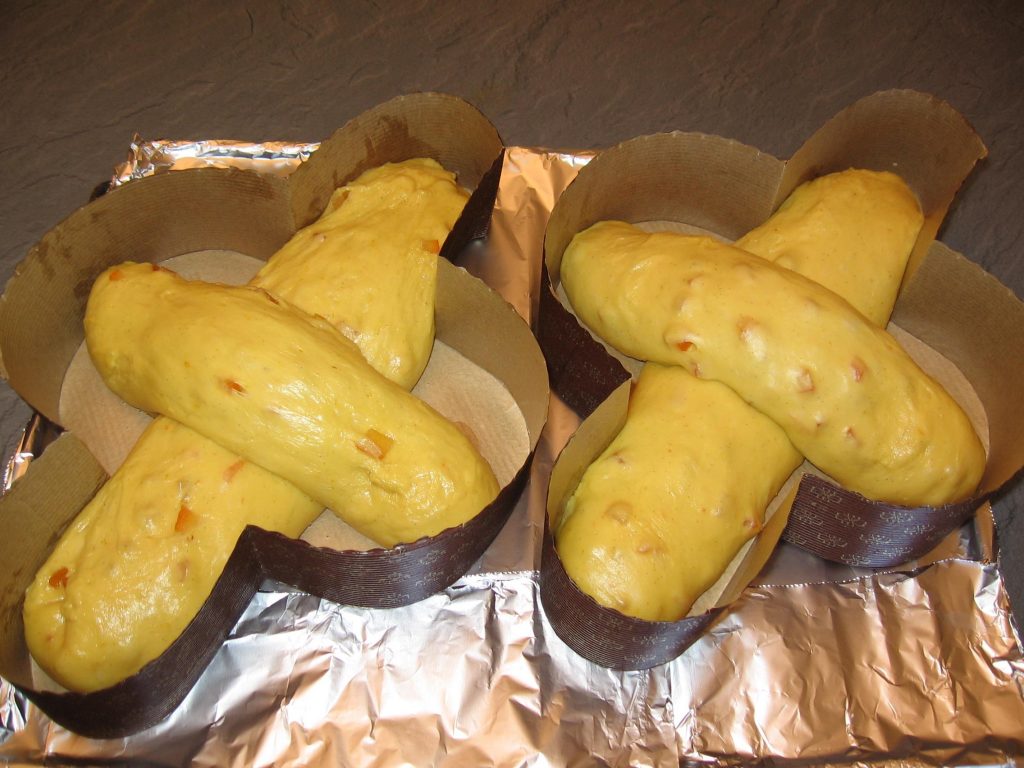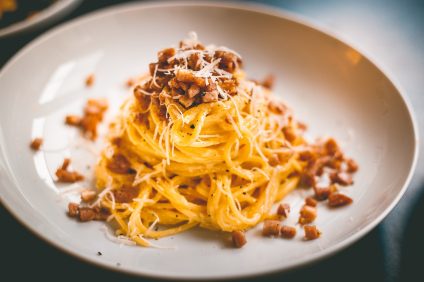Easter cake
Robert Saluzzi

Time of realization: 2 days
Degree of difficulty (1 to 5): 5
Ingredients for 2 doves:
1st dough:
500 g of strong flour
180 g of sugar
160 g of mother yeast
190 g of cold water
125 g of yolks
160 g of butter
2st dough:
150 g of strong flour
125 g of yolks
120 g of sugar
30 g of honey
10 g salt
1 vanilla bean from Madagascar
220 g of butter
350 g of candied orange
For the glaze:
50 g almonds
50 g of hazelnuts
100 g of kernels
300 g of sugar
10 g of bitter cocoa
40 g of corn starch
100 g of egg white
To decorate:
to taste of skinned but not roasted almonds
to taste of granulated sugar and powdered sugar
Method
1) Before proceeding, the yeast must be refreshed at least three times at a temperature of 26 ° C, so that it gains strength and releases a fresh and soft scent of bread; the alveolation must be homogeneous and soft, so as to make it look like a cloud. You shouldn't smell any acid or vinegar and it shouldn't be too sticky.
2) For each refreshment it will take at least 3-4 hours, the important thing is that each time it is completely leavened, that is, that it has more than doubled in volume.
3) There are 3 methods to start working the dough: a) Put the yeast in the bowl of the planetary mixer and dissolve it in the water with one hand, add the sugar, ⅔ of the egg yolks and operate the dough hook at high speed, so to mix everything and start incorporating air. A froth will form. Add the flour all together. Work at minimum speed and for a short time, so as not to fully develop the gluten and thus obtain an opaque and sticky mass. Incorporate the remaining egg yolks in 2 times, and work a little.
b) Another method: put the flour, yeast and sugar in the mixer, operate at minimum and add the water a little at a time. Add the egg yolks 3-4 times.
c) A third method, much less academic and which could arouse many perplexities but also irritation among the "master" bakers, is the opposite procedure compared to the previous ones: it is always said to put the fats at the end because they do not allow the formation of the gluten mesh ... well, starting with ¾ of the dose of soft butter, a part of flour and then adding the liquids, alternating with the remaining butter and flour, the dough will be exactly as elastic as that obtained with the "classic" method.
Before shouting scandal and accusing me of blasphemy, try it.
If you adopt one of the first two methods, make the butter soft while kneading, if necessary put it in the microwave for a few seconds, making sure it does not exceed the temperature of 18-19 ° C.
4) During processing, be very careful that the walls of the planetary mixer do not heat up, compromising the "life" of the yeast and the destruction of the gluten mesh. If you are not sure of the temperature of the dough, stop the machine and check the inside of the dough with a probe thermometer, which must never exceed 26 ° C.
5) Add the butter, at first a small piece, then bigger and bigger pieces, and do everything quickly, in order to work the mass as little as possible. Always carefully check the internal temperature of the dough.
The working time of this first mix will be around 20-25 minutes.
6) Remove it from the planetary mixer, work it on the work surface or between your hands in order to give it a homogeneous, very soft and sticky appearance. Put it in a large bowl, with a tarot give it a sphere shape, cover it with a cloth and place it in the lukewarm for the whole night, or approximately for 8-10 hours. The temperature must be between 26 and 28 ° C.
7) I adopt a very "homemade" but effective method, to ensure the right warmth and its constancy over time: I put the bowl in an electric blanket folded like a sandwich, I adjust the temperature as I want and even for 12 hours I can afford to feel comfortable.
8) The next morning the pasta must have filled the bowl and formed a well elastic and fragrant dome, tripling the initial volume: put it in the mixer, add the flour all together and work at very low speed, until the flour is absorbed.
9) Add a little egg yolk at a time alternating with sugar and honey.
10) Check the temperature even more carefully in this phase: it must never exceed 26 ° C. This is a delicate phase, perhaps the most dangerous for the success of the dessert, and will determine the success of your work. If it gets hot even a little, stop immediately and spread the dough to let it cool, you can even place the whole bowl in the refrigerator; wait a few minutes and slowly resume work until the dough begins to detach from the walls.
11) Add the salt a little at a time and the vanilla seeds.
12) Finally add the butter as you did with the first dough: only a piece then more and more quantities. It is essential to work the pasta a little in these last steps.
13) Always turning the planetary mixer at minimum speed, gradually add the candied fruit, work as little as possible and finish the work by hand and quickly to distribute everything evenly. The working time used for this second mix will be around 25-30 minutes. Place the dough in a bowl, cover with a cloth and let it rest at room temperature for an hour: this phase is called "puntatura".
14) Divide the dough into two equal parts, and take 1/3 from each part (this is called "size"), for all 4 pieces do the "pirlatura", ie roll them with the palms of your hands on the work surface sliding them from hand to hand and making them smooth and pulled to the surface.
15) Prepare two baking cups with a capacity of one kilo each.

16) After a few minutes, turn the dough on themselves to make them homogeneous and make another "pirlatura". Stretch them like cylinders.
17) Place the larger portions in the baking cups and cross the smaller portions. Place everything under the electric blanket at a temperature of 28-30 ° C.
Another "tip" would be to get a sheet of coated wire mesh, the kind used to make plants climb: you can model it according to the shape of the baking cups and place it on top of them, in order to lift the electric blanket and prevent it from touching the dough.
18) After at least six hours the masses should have reached the edge and the center should have exceeded it by even two centimeters. Meanwhile, prepare the glaze by mixing all the ingredients; keep refrigerated until use.

19) Turn on the oven at 175 ° C.
20) Put the icing in a pastry bag fitted with a nozzle with a flat tip. Distribute it on the surface of the doves in a thin and homogeneous layer; add abundant almonds and grains, sprinkled with icing sugar.
21) Bake immediately on the lowest level of the oven and cook for 50-55 minutes, depending on your oven. Pay attention to the color of the surface during the first 5-10 minutes, covering with aluminum foil or baking paper to prevent it from burning.
22) As soon as they are taken out of the oven, skewer the base of the doves laterally with the special skewers or with two knitting needles 3.5 and turn them over, placing them on the sides of two chairs or hung with ropes. Leave them for 12 hours to cool and settle upside down, "upside down".

23) Sprinkle pure alcohol at 95 ° for food on the inside of polypropylene bags before putting the doves in them and enjoy them after at least a week. They also last two months, but I've never been able to keep them for so long ...









